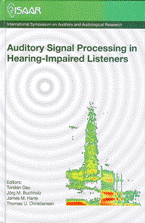Demonstration of a portable system for auditory brainstem recordings based on pure tone masking difference
Resumé
The auditory brainstem response (ABR) has for many years been an important research tool. It has been used in many different settings from threshold determination on subjects unable to participate in ordinary psychoacoustic testing, to diagnosing tumours on the auditory nerve. The problem with most ABR systems is that they are either big, inflexible or both. Furthermore, most systems are not portable. We have developed an ABR system based on a Tucker-Davis Technologies differential amplifier and portable digital signal processor (RM2). The differential amplifier is connected via an optical cable. This system is small, weighing less than 750 grams including batteries. It is also very flexible with a graphical pro- gramming interface that makes it possible with relative ease to modify the entire system and it is relatively inexpensive (approximately 2000 USD). We have implemented a pure tone masking difference ABR method (Ber- lin1991) The system has been developed for human ABR measurements and will be demonstrated at the symposium. To explore the possibilities of the system we have also used it to determine the audiograms for frogs (Rana temporaria, Xenopus tropicalis) and lizards (Gekko gecko). The audiogram is difficult to measure by behavioral methods since lizards and frogs cannot be conditioned to acoustical stimuli. ABR measurements are therefore the most convenient way to compare thresholds in the different species.
Referencer
Katbamna, B., Brown, J. A., Collard, M., and Ide, C. F. (2005). “Auditory brainstem responses to airborne sounds in the aquatic frog Xenopus laevis: correlation with middle ear characteristics,” J. Comp. Physiol. A. 192, 381-387.
Yderligere filer
Publiceret
Citation/Eksport
Nummer
Sektion
Licens
Authors who publish with this journal agree to the following terms:
a. Authors retain copyright* and grant the journal right of first publication with the work simultaneously licensed under a Creative Commons Attribution License that allows others to share the work with an acknowledgement of the work's authorship and initial publication in this journal.
b. Authors are able to enter into separate, additional contractual arrangements for the non-exclusive distribution of the journal's published version of the work (e.g., post it to an institutional repository or publish it in a book), with an acknowledgement of its initial publication in this journal.
c. Authors are permitted and encouraged to post their work online (e.g., in institutional repositories or on their website) prior to and during the submission process, as it can lead to productive exchanges, as well as earlier and greater citation of published work (See The Effect of Open Access).
*From the 2017 issue onward. The Danavox Jubilee Foundation owns the copyright of all articles published in the 1969-2015 issues. However, authors are still allowed to share the work with an acknowledgement of the work's authorship and initial publication in this journal.


